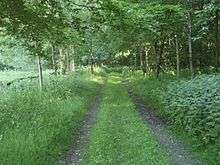Ashton Wold
Ashton Wold is a 54.0 hectare biological Site of Special Scientific Interest (SSSI) east of Oundle in Northamptonshire.[1][2] It is part of the Ashton Estate, which was purchased in 1860 by Lionel de Rothschild, a banker and politician. His grandson, Charles Rothschild, the founder of the Society for the Promotion of Nature Reserves, now The Wildlife Trusts, built Ashton Wold House, which was designed by Wiliam Huckvale. The house and its garden are listed on the Register of Historic Parks and Gardens by English Heritage for their historic interest, and part of the garden is woodland which is designated as Ashton Wold SSSI. Part of the estate is the subject of a Restrictive Covenant between Charles's daughter Miriam Rothschild and the National Trust in 1945.[3]
| Site of Special Scientific Interest | |
 | |
| Area of Search | Northamptonshire |
|---|---|
| Grid reference | TL 091 875[1] |
| Interest | Biological |
| Area | 54.0 hectares[1] |
| Notification | 1990[1] |
| Location map | Magic Map |
Ecology
The SSSI is ancient secondary woodland with mature oak, ash and birch trees. The thick shrub layer includes hawthorn and buckthorn. There are breeding birds such as woodcocks and hawfinches.[4]
Access
There is access from Lutton Road.
References
- "Designated Sites View: Ashton Wold". Sites of Special Scientific Interest. Natural England. Retrieved 19 December 2016.
- "Map of Ashton Wold". Sites of Special Scientific Interest. Natural England. Retrieved 19 December 2016.
- "Ashton Wold. List entry Number: 1001715". Historic England. Retrieved 19 December 2016.
- "Ashton Wold citation" (PDF). Sites of Special Scientific Interest. Natural England. Archived from the original (PDF) on 4 March 2016. Retrieved 19 December 2016.